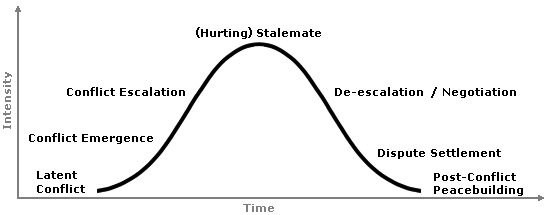The following text is from https://www.beyondintractability.org/essay/conflict_stages. Click on the hyperlink’s to visit their site and read as needed.
“It has become common to describe conflicts as passing through a series of phases.[1] Different authors name and describe these stages differently, but most include, at a minimum:
These phases are frequently shown on a diagram that looks something like this, although the accompanying text will always explain that the progress from one stage to the next is not smooth and conflicts may repeat stages several times.

These stages are described briefly in this introductory essay, and then each is discussed in more depth in other essays.
The potential for conflict exists whenever people have different needs, values, or interests; this is the “latent” conflict stage. The conflict may not become apparent until a “triggering event” leads to the emergence (or beginning) of the obvious conflict. Emergence may be followed quickly by settlement or resolution, or it may be followed by escalation, which can become very destructive.
Escalation, however, cannot continue indefinitely. De-escalation can be temporary or can be part of a broader trend toward settlement or resolution. Or escalation may lead to a stalemate, a situation in which neither side can win. If the pain of continuing the conflict exceeds that of maintaining the confrontation, the parties are in what Zartman calls a “hurting stalemate,”[2] which often presents an ideal opportunity for negotiation and a potential settlement. Finally, if and when an agreement is reached, peacebuilding efforts work to repair damaged relationships with the long-term goal of reconciling former opponents.
Some scholars add other phases to this list. For intractable conflict, in particular, Kriesberg adds failed peacemaking efforts after escalation, and institutionalization of destructive conflict after that.[3] This latter stage is closely linked with the hurting stalemate.“
